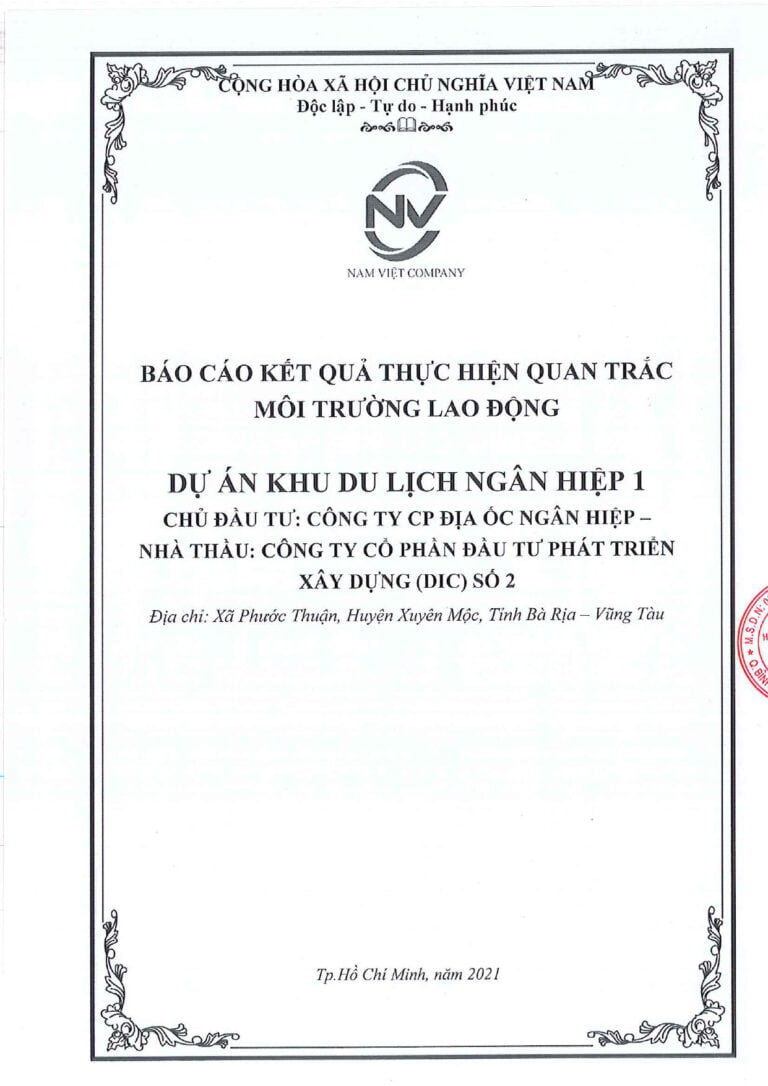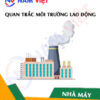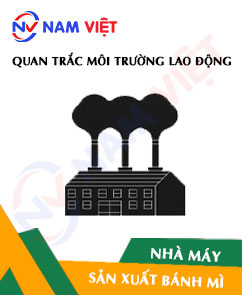Occupational Environment Monitoring at Iron Manufacturing Factory
99,000 ₫
Note: The above price is calculated per sample and may vary depending on the area of the environment to be monitored and market fluctuations. For more accurate pricing support, please refer to the price list or contact our consulting staff directly.
Monitoring the environment of an iron production factory is a session for collecting, analyzing, and evaluating workplace factors that may be harmful to workers’ health.
Table of Contents
Toggle1. Overview of Iron Manufacturing Factory
a. What is an iron manufacturing factory?
Iron manufacturing factory is a facility that produces irons, devices used to flatten and soften various types of fabrics. Irons are widely used in the garment industry, hotels, hospitals, and households. Iron manufacturing factories typically have production and assembly processes to create high-quality products, including steam irons and non-steam irons.

b. Production stages in the iron manufacturing factory
The production stages in an iron manufacturing factory may include:
- Component processing: Before assembly, iron components are processed from materials such as steel, aluminum, plastic, and others. This process includes cutting, bending, welding, grinding, and precision machining to produce accurate and high-quality parts.
- Assembling the iron frame: Components are assembled into the iron frame, including the base, upper frame, and lower frame. This assembly process typically involves welding, screwing, or using other techniques to connect the components.
- Installing control systems: Modern irons are often equipped with control systems to adjust temperature, steam pressure, and other settings. During production, these systems are installed and tested to ensure accurate and safe operation.
- Installing the ironing surface: The ironing surface is usually made from materials like stainless steel or aluminum. During production, the surface is mounted on the iron frame and calibrated to ensure flatness and precision.
- Installing the steam system: For steam irons, installing the steam system is a crucial step. This system includes a water tank, steam controller, and heat pipes to supply steam to the iron.
- Inspection and quality control: After assembly, irons undergo inspection and quality control processes. This ensures that the irons operate accurately, safely, and reliably before packaging and shipment.
- Packaging and shipping: Once production and quality inspection are complete, irons are packaged and prepared for shipping. Packaging includes protective wrapping, standard packing, and attaching manuals and accessories. The irons are then transported to distributors or end customers.

c. Machinery used in the iron manufacturing factory
Iron manufacturing factories use various types of machinery for production and processing. Some commonly used machines include:
- Steel cutting machine: Used to cut metal parts such as bases and iron frames from steel sheets.
- Steel bending machine: Used to bend steel bars to create curved parts like bases and frames.
- Welding machine: Used to weld metal components together, including spot welding and seam welding.
- Grinding machine: Used to grind and smooth metal surfaces of iron components.
- Precision machining equipment: Machines such as milling machines and lathes are used for precision machining to ensure the accuracy and flatness of parts.
- Heat press machine: Used to flatten and bond surface materials like rubber or fabric onto iron components.
- Fabric cutting and sewing machines: In some cases, factories use these machines to produce and assemble fabric parts such as protective covers or linings.

d. Occupational diseases for workers in the iron manufacturing factory
Workers in the iron manufacturing factory may suffer from some occupational diseases related to the work environment and production process. Common occupational diseases in the iron manufacturing sector include:
- Respiratory diseases: Workers may be exposed to fumes, dust, and vapor during welding, grinding, and metal processing, leading to respiratory inflammation, asthma, and other respiratory issues.
- Heat-related illnesses: Some production stages generate high temperatures, posing risks of burns or heat-related health problems. Workers must follow safety measures to prevent burns and protect their health.
- Work accidents: Machinery and equipment in the factory may cause accidents if safety rules are not followed. This includes risks of crushing, cutting, impact injuries, and other machine-related accidents.
- Hand disorders: Workers may develop hand problems such as dermatitis, cuts, burns, or musculoskeletal issues due to handling sharp or hot tools and machinery.
- Chemical exposure: The production process may involve chemicals like solvents, adhesives, or cleaning agents. Prolonged exposure can cause skin irritation, respiratory issues, or other health problems.

e. Popular types of irons on the market
There are various types of irons on the market with diverse features to meet consumer needs. Some popular types include:
- Steam irons: The most common type, producing steam to moisten and soften fabric, making it easier to iron out wrinkles.
- Dry irons: Traditional irons without steam functionality, used for ironing dry fabric.
- Steam and dry irons: Can operate in both steam and dry modes, allowing user customization.
- Vertical irons: Specially designed to iron vertical surfaces such as curtains, jackets, or large fabrics.
- Mini irons: Compact and lightweight, suitable for small details like children’s clothes, shirts, or for travel.
- Automatic function irons: Equipped with features like automatic shut-off, anti-drip, or auto temperature adjustment.
- High-pressure steam irons: Capable of producing high-pressure steam to remove stubborn wrinkles on fabric.
2. Overview of occupational environment monitoring service
a. What is occupational environment monitoring at the iron manufacturing factory?
Occupational environment monitoring (or workplace environment measurement) at the iron manufacturing factory is the activity of collecting, evaluating, and analyzing measurement indicators of workplace environmental factors. The goal is to take timely corrective actions, minimize environmental harm to worker health, and prevent occupational diseases. Occupational environment monitoring is a mandatory requirement for iron manufacturing factories.
It plays a crucial role in protecting, caring for, and enhancing worker health, as workers are the primary resource of a business and directly generate profit. Workers frequently exposed to risks and harmful factors above permitted standards can suffer health impacts and occupational diseases.
REGISTER FOR OCCUPATIONAL ENVIRONMENT MONITORING SERVICE
b. Nam Viet’s occupational environment monitoring program
Nam Viet’s occupational environment monitoring program is researched by monitoring engineers in occupational safety and environmental protection. To ensure worker health and safety, the program uses modern measurement methods to monitor air quality, water, microclimate, physical factors, dust, and more in the workplace. This program is essential for ensuring a safe working environment and protecting worker health.
Additionally, Nam Viet’s program plays an important role in researching and developing new solutions to improve workplace quality. With a dedicated and professional team of monitoring experts, Nam Viet’s exclusive monitoring program is a breakthrough in labor safety management and environmental protection in Vietnam.

c. Standardization in workplace environment measurement procedures
Standardization in Nam Viet’s workplace environment measurement procedures is critical to ensure measurement accuracy. To guarantee reliable results, the program follows standards and procedures recognized by Ho Chi Minh City Department of Health. This ensures collected data can be reliably used for workplace environment evaluation and decision-making to protect worker health.
These standardized procedures also ensure measurements are performed by highly qualified monitoring specialists with years of experience, allowing managers and experts to trust Nam Viet’s results for accurate and valuable decisions in safeguarding worker health and the environment.
By applying standardized procedures, Nam Viet demonstrates its commitment to a safe working environment and worker health, while contributing to the development and improvement of labor safety and environmental management in Vietnam.
d. Reporting results of occupational environment monitoring at the iron manufacturing factory
Monitoring results are prepared according to Form No. 04, Appendix III of Decree 44/2016/ND-CP and produced in two copies: one sent to the workplace contracting the monitoring service and one kept by the monitoring organization.
The retention period for monitoring results is indefinite according to legal regulations.

e. Frequency of occupational environment monitoring according to the law
According to Clause 2, Article 18 of Labor Safety and Hygiene Law 84/2015/QH13, employers must conduct workplace environment monitoring to assess harmful factors at least once a year.
f. Deadline for submitting occupational environment monitoring reports
The deadline for submitting reports is before December 31 each year. Enterprises of production facilities must submit monitoring results to the local Department of Health where the business has its headquarters and where employees are working.
When there are changes in technology, production processes, or upgrades that could introduce new harmful factors, enterprises must update occupational hygiene records regarding harmful factors requiring environmental monitoring.
g. Penalties for violations of occupational environment monitoring by employers
According to Article 27 of Decree No. 12/2022/ND-CP dated January 17, 2022, on administrative penalties in labor, social insurance, and Vietnamese workers working abroad under contract:
- Clause 2: Fine of 2,000,000 – 5,000,000 VND for employers who do not publicly inform workers at the monitored workplace about the monitoring results and the assessment and management of hazardous factors immediately after obtaining results.
- Clause 3: Fine of 20,000,000 – 40,000,000 VND for employers who fail to conduct occupational environment monitoring to control health hazards as required by law.
- Clause 4: Fine of 40,000,000 – 60,000,000 VND for employers who collude with monitoring organizations to commit fraud in environmental monitoring activities but have not reached the level of criminal liability.
3. Harmful environmental factors for workers in the iron manufacturing factory
Workers in iron manufacturing factories may be exposed to several harmful environmental factors. Some potential hazards affecting worker health include:
- High temperature: Working near hot machinery can cause high temperatures, leading to fatigue, stress, and potential risk of depression.
- Dust and chemical vapors: Processing materials and chemical usage can produce dust and vapors, causing skin, eye, and respiratory irritation, as well as health issues like rhinitis, pneumonia, and allergies.
- Noise: Machinery can generate high noise levels. Prolonged exposure may lead to stress, insomnia, reduced concentration, and negative auditory effects.
- Flammable substances: Workers may encounter flammable substances during work, requiring strict fire safety compliance.
- Other toxic substances: Chemical compounds in production may cause health issues ranging from skin irritation to organ damage if exposed improperly over long periods.
REGISTER FOR OCCUPATIONAL ENVIRONMENT MONITORING SERVICE
4. Measures to Improve the Working Environment in Iron Manufacturing Factories
To improve the working environment in iron manufacturing factories, the following measures can be applied:
- Dust management and control: Use effective dust extraction systems and personal protective equipment to prevent dust dispersion during production. Ensure regular cleaning and hygiene in the working area to remove dust.
- Improve ventilation: Ensure ventilation systems operate effectively to remove chemical fumes and unpleasant odors during production. Provide sufficient fresh air in the working area.
- Reduce noise: Apply soundproofing and insulation measures for machinery, provide ear protection for workers, and regularly inspect and maintain machinery to reduce noise levels.
- Ensure electrical safety: Inspect and maintain electrical systems, ensure proper grounding, and check electrical devices. Train employees on electrical safety and implement safety rules.
- Toxic substance management: Ensure the safe use and storage of toxic substances according to regulations. Provide personal protective equipment such as masks and gloves to protect workers from direct contact with toxic substances.
- Training and awareness raising: Train workers on occupational safety, hazard recognition and preventive measures, proper use of safety equipment, and personal hygiene rules.
- Regular inspection and maintenance: Perform regular inspection and maintenance of equipment and machinery to ensure effective and safe operation.
- Periodically conduct occupational environment monitoring in factories, collect and analyze harmful factors for workers, and adjust measures to reduce hazards and prevent occupational diseases.
5. Benefits of Regular Iron Factory Environmental Monitoring
An Toan Nam Viet provides enterprises with excellent benefits when using occupational environment monitoring services in accordance with Decree 44/2016/ND – CP on managing and controlling harmful factors in the working environment affecting workers.
- Enterprises can proactively control harmful factors in workshops or factories.
- Receive professional recommendations to mitigate hazards and improve working environment quality.
- Indirectly protect human resources, a key factor in business development.
- Minimize the impact of occupational diseases on health, reducing future treatment costs.
- Improved worker health leads to better product quality and consistent output.
- Ensure compliance with occupational safety laws and avoid legal risks.
- Enhance enterprise credibility and professionalism, elevating the brand.
Nam Viet’s environmental monitoring service is a solution to reduce occupational disease hazards, contributing to a clean and high-quality working environment.

6. Nationwide Occupational Environment Monitoring Center
Nam Viet Occupational Environment Monitoring Center is a professional unit specializing in monitoring and measuring occupational environment quality across all provinces in Viet Nam. With a team of experienced monitoring specialists, the center uses modern measuring equipment to ensure accuracy and reliability.
In addition to monitoring services, the center assists clients in planning, handling, and tracking occupational environment issues. With the motto “customer-centric,” the center prioritizes client satisfaction, meets all client needs, and commits to providing the best solutions for enterprises.
REGISTER FOR OCCUPATIONAL ENVIRONMENT MONITORING SERVICE
With investment in technology, equipment, and personnel, Nam Viet’s monitoring center has become one of the most reputable units in occupational environment monitoring in Ho Chi Minh City, with the following objectives:
- We always value our brand reputation and the quality of our services.
- We provide clients with the best and most suitable solutions.
- With a team of experienced Masters and Engineers, committed to protecting the environment and benefiting enterprises.
- Clients using Nam Viet Environmental Monitoring will receive professional service from experts in the field, along with the best cost advantages.
The occupational environment monitoring process at Nam Viet includes the following basic steps:
- Before conducting monitoring, we ensure that all equipment is calibrated and meets legal requirements.
- Follow the occupational environment monitoring procedures as committed to the Department of Health.
- Accurately report monitoring results to employers.
- If monitoring results indicate unsafe conditions for workers, Nam Viet will assist in implementing corrective measures, and the enterprise will:
- Implement measures to improve working conditions and minimize harmful factor impacts, preventing occupational diseases.
- Organize health check-ups to detect occupational and related diseases early for workers in unsafe environments.
- Provide compensation in kind for workers according to labor law regulations.

7. Occupational Environment Monitoring Price List
To help enterprises conduct professional and effective occupational environment monitoring, Nam Viet provides clients with a detailed price list for monitoring services that is high-quality and reasonably priced.
- Our price list provides detailed information about monitoring service costs, including transportation, measurement, analysis, and report preparation. Clients can trust the accuracy and reliability of our monitoring reports.
- We commit to offering competitive and reasonable prices while providing prompt and professional consultation for any monitoring service inquiries.
- With Nam Viet’s price list, clients can easily select service packages that suit their needs, ensuring maximum satisfaction with professional service quality.
No comments yet












Review Occupational Environment Monitoring at Iron Manufacturing Factory
There are no reviews yet.